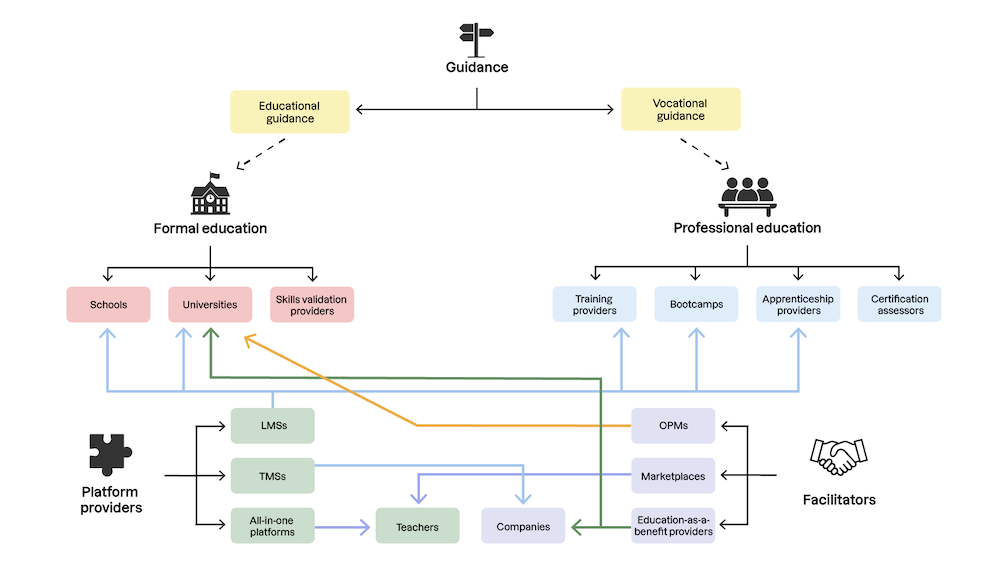Education is such a vast ecosystem! In this chapter, we’ll take a look at the different providers working in the education sector. I want to give you an overall idea of who they are, what they do and how they interact with each other. 🤝
This might be a lot for you to learn. If you’re confused, don’t worry, this is perfectly normal! You’ll come back to this chapter later for future reference. Imagine it’s like a big map: you don’t need to know all of this by heart, but it’s helpful for you to navigate. 🗺
I have organized providers in different categories to help you understand better:
Guidance: all providers dedicated to guidance, helping students find what they want to do, what they need to learn, and for which job. While there is no formal training happening, their role before and after the training is absolutely critical!
Formal education: providers dedicated to formal education, or what some people call “traditional” education. Think about schools and universities.
Professional education: lifelong learning providers. They come on the scene after, or sometimes in lieu of, formal education. The training they offer is usually less time intensive and focused on skills that have the most impact on people’s day-to-day job.
Platform providers: they offer technical solutions to other education providers. Think of them as “brick providers”. They don’t teach, but they help teachers do their work.
Facilitators: they connect different stakeholders, like companies with formal/professional education providers.
Here’s a visual aid of what we’re going to go through:
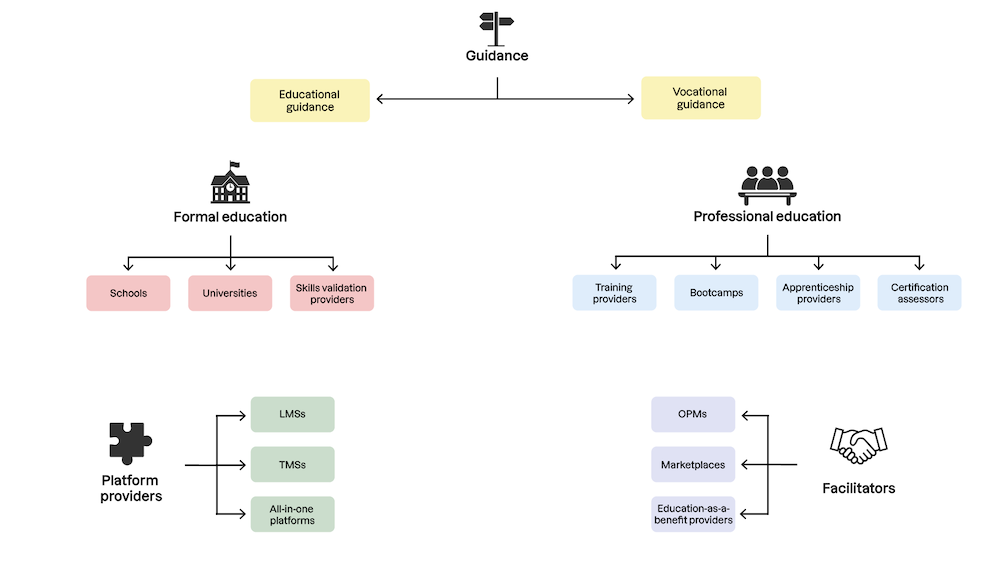
Guidance
Some might say guidance is not really “education”. It’s a step outside of education, to guide you in the direction that is right for you.
However, I’d consider guidance providers as important as education providers, if not more. In fact, guidance makes you learn what you can learn. Read that twice. It’s critical to know where you can go, which job you want to do and what kind of training you need to achieve your goal.
Too often, students rush to sign up for the first training that looks good to them without assessing if this is really what they want. What a waste of time it can be! So many people spend years on a training program that was not for them, find a job that was not for them, until they realize years later that they should have learned something else in the first place.
There are 2 types of guidance:
Educational guidance
Vocational guidance
Educational Guidance
Educational guidance is about finding the right training for you.
What do you want to learn? Where do you want to learn it? How?
Educational guidance is particularly helpful for children and young adults before they start working. They will be choosing an educational institution, choosing courses and subjects, developing study habits, obtaining scholarships, making curricular adjustments based on their capacity or ability, etc.
Educational guidance is mostly provided by the head teacher from within the school for K-12 students.
Vocational Guidance
Vocational guidance is about finding the right job.
As the job market evolves quickly due to technological advances, it becomes even more important than before to know in which direction you want to go.
What kind of job do you want to do? What kind of salary do you want? What are your interests, aptitudes and abilities?
With that information, vocational guidance providers can help you choose the right job and – if necessary – the right training you need to get there.
Vocational guidance can be done inside of schools & universities by a dedicated department, but there are usually external providers who specialize in this.
🇺🇳 Country by Country
🇺🇸 USA
In the US, schools and further education colleges traditionally have provided guidance through their in-house career counselors.
Learners and individuals also have access to a number of self-evaluation tools so they find out about vocational training opportunities and training providers, and there are paid services and career coaches that people can contract for personalized service.
Finally, under the Workforce Innovation & Opportunity Act (WIOA), people in the US may visit their local American Job Center for job search help, skills assessment, recommendations to training programs listed on their Eligible Training Providers List (ETPL), and more.
🇬🇧 UK
In the UK, schools and further education colleges operating within the state sector traditionally have provided guidance. Recently legislation has been introduced expecting each institution to appoint a “Careers Leader” to provide advice. This provision is monitored and audited.
The majority of UK schools and colleges collectively belong to regional “Career Hubs” where information and resources are shared and this includes contributions from employers.
Learners and individuals also have access to a number of self-evaluation tools so they find out about vocational training opportunities and training providers.
For individuals who are not in full-time education, the UK government's National Careers Service provides guidance for adults and young people. This comprehensive service is a valuable resource specifically for those who wish to change career direction and those who are unemployed and wish to find training to improve their chances of finding work.
🇫🇷 In France, “Le bilan de compétences”
In France, it’s usual to make a formal “bilan de compétences” (skills assessment) to help you find what you like to do and how you should prepare yourself for a new job.
You can do this skill assessment at a “Centre de bilan de compétences” (skills assessment center). It is provided to workers who want to take a break and analyze what they want to do, going forward in their life. It can be funded through the CPF credits each worker gets during their professional life.
Note that OpenClassrooms trains for the “Conseiller emploi et évolution professionnelle” job, which is the type of skills these centers need.
Formal Education
Formal education is the traditional part of education. It happens mostly during the early years, before people start working.
Schools
Schools are the most well-known education providers. These organizations train students – in this case more specifically K-12 students.
I have detailed a bit what they are in the first chapter already, so I’m not going to repeat myself here. 😉
Universities
Universities (or colleges) are another key element of formal education. They teach students after K-12, but before people enter into the workforce.
Universities are not only about learning knowledge but also about producing knowledge: research is an important part of their role. In fact, most teachers are evaluated on the research they produce more than their teaching. You can get more details about how the university works – and how it’s trying to change – by reading “The Innovative University” by Clayton M. Christensen (who happens to be a Harvard teacher!).
While people usually go to the university before they start working, they can also go back to university for what we call continuing education. That’s why you can see older adults at university too. 😉
Skills validation providers
At school and university, you learn and acquire new skills. But what if you got your skills through experience, without formal education? It means you have all the skills for the job… but no qualification that would testify that you have those skills.
That’s why it’s possible to get the same qualification that you would have if you went to university, without having to learn what you already know.
This process, to my knowledge, is only available in France 🇫🇷. It’s called VAE : “Validation des Acquis de l’Expérience” (validation of skills acquired through experience).
Some providers, like Les 2 Rives, are fully dedicated to VAE. However, most of the time, a VAE can be done directly within universities and other post-secondary institutions as they have to provide a VAE process by law. It’s an alternate process for those who didn’t go to university but still want to prove that they have the same level as the people who went.
Professional education
The providers in this section are either:
Dedicated to training existing workers or job seekers, either to advance in their current role, or to switch careers entirely
Directly connected with companies in one way or another
People often say that schools and universities are a bit disconnected from the working world. Some say it’s on purpose (they focus more on creating knowledge, elevating minds, etc.).
Whether you agree with this or not, several providers are trying to bridge the gap between formal education and companies.
Training providers
Training providers offer upskilling services: workers can get better at a specific skill or skillset. There are many training providers. Their training programs can happen in person or online – most of them are in person, although the online share is growing. Training programs last from a few hours to a few days in most cases.
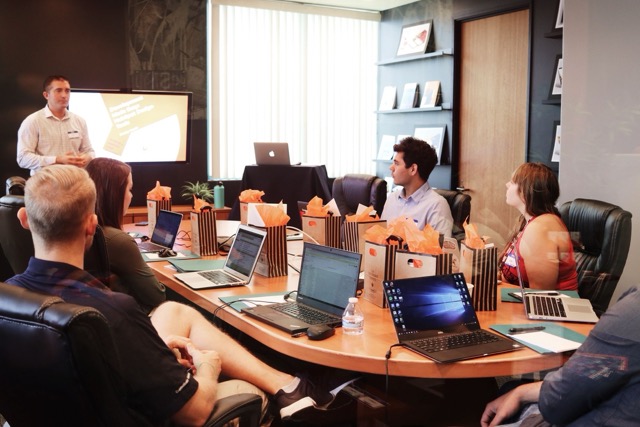
In general, these providers are training small groups of people (less than 20).
Some training programs cover common and general stuff (leadership, stress management, English as a second language…), others can be very specific (”Data storytelling best practices with Tableau”).
🇺🇳 Country by Country
🇬🇧 UK
There are many private training providers in the UK delivering vocational training across all subject areas. Sometimes private providers are referred to as alternative training providers. As in France, some are very small and specialist and some train many thousands of learners. Some of the largest providers are QA, Lifetime Training, Capita, Kaplan, BPP.
🇫🇷 France
There are lots of professional training providers in France (more than 90,000 providers as of 2021). Many are very small with just 1 trainer. Others are bigger and more established: among them, CEGOS and DEMOS. CEGOS had a revenue of 142m€ in 2020.
Bootcamps
Bootcamps are a new training format that is shorter than a formal education, but longer than the usual professional training. Bootcamps generally last from a few weeks to a few months, although some can be longer if they train at a slower pace.
The name “bootcamp” comes from the military: it’s a training camp for new recruits with very harsh discipline. In practice, it’s much softer in the training world let me reassure you. 😅
Bootcamps are seen as an accelerator for students who need additional training after their formal education to bridge the gap with their future workplace requirements. They are quite intense and often focus on coding skills.
Bootcamps usually don’t offer formally State-endorsed degrees like universities do.
🇺🇳 Country by Country
🇺🇸 USA | 🇬🇧 UK | 🇫🇷 France |
|---|---|---|
General Assembly | General Assembly | Le Wagon |
Hack Reactor | Makers | Ironhack |
Flatiron School | Le Wagon | La Capsule |
Bloom Institute of Technology (formerly Lambda School) | Ironhack | Simplon |
Thinkful | Hyperion Dev |
|
N.B.: the UK Department of Education are now funding Skills Bootcamps available to Learners aged 19+
Apprenticeship Providers
Apprenticeship is a different learning model where the student works and learns at the same time (usually 3-4 days at work per week, and 1-2 days of learning). Because of this, there are specific apprenticeship providers that are designed to run this type of program.
Apprenticeship programs can be quite complex to manage. We can distinguish several roles:
Sponsors: they manage and run the apprenticeship program. They are the ones responsible for the apprenticeship program: they design and execute the program, make sure everything is working as intended.
Facilitators: they help connect companies with students. Companies want to hire apprentices, students need to find a company to host their apprenticeship. Facilitators are here to make that happen.
Training providers: they deliver the training part of the program (this is the “school” part).
Assessors: they check that the students have the skills throughout or at the end of the training, to deliver the qualification.
Sometimes, these roles are handled within the same organization, but they can also be handled by different organizations.
🇺🇳 Country by Country
🇺🇸 USA
Apprenticeships in the US are not really new but not really widespread either. Apprenticeship is often unknown or confused with lower value internships. Most apprenticeships in the US are in construction or the military. Tech apprenticeships (data analysis, web development, etc.) are actually less than 1% of registered apprenticeships!
In the US, apprenticeship responsibilities are split between different stakeholders:
Sponsors: this is the organization, person or employer running the apprenticeship program. They are responsible for the program’s compliance with the Department of Labor. They run a RAP (Registered Apprenticeship Program). Sponsors can be found on https://www.apprenticeship.gov/partner-finder
Facilitators: they connect students with employers. Apprenti is one well-known facilitator.
Training providers: they conduct the RTI (Related Training Instruction) and provide the training, which must be a minimum of 144 hours / year. The rest is called On The Job training (OTJ). Some RTIs also operate bootcamps, like General Assembly & Tech Elevator.
Assessor: the training provider plays the assessor role, as in France. It’s a bit less formal than in France, and way less formal than in the UK.
🇬🇧 UK
In the UK, apprenticeships are mostly used by existing employees at companies who need to upskill. This is different from France and the US, where apprenticeships are a way for companies to attract new talent.
In the UK, apprenticeships are strictly regulated. There are apprenticeship training providers who prepare students for End-point Assessments, which are the final stage of apprenticeships run by an independent organization (EPAO: End Point Assessment Organization).
🇫🇷 France
In France, all the apprenticeships roles are usually combined into one. The apprenticeship provider is playing the role of the sponsor, facilitator, training provider and assessor.
There are 2 types of apprenticeships contracts: “Contrat d’apprentissage” (mostly for young people less than 30 years old) and “Contrat de professionnalisation” (for jobseekers changing careers).
Apprenticeships programs for “Contrats d’apprentissages” are mostly operated by CFAs (Centres de Formation d’Apprentis), who have always been important providers. Regulation has been simplified and now it’s possible to run an apprenticeship program even if you’re not formally a CFA.
Contrary to the UK, the final assessment is done by the same organization that delivers the training.
Certification Assessors
These commercial entities are focused on delivering specific industry-recognized certifications. They are not really diplomas or degrees, but they have an important value in the eyes of employers.
Assessors do not train: they only confirm that a person has reached a specific level.
Some famous certification assessors include:
TOEIC and TOEFL: English level certification, run by ETS Global
CCNA: a network certification by Cisco
MCP: a set of certifications by Microsoft
These assessors charge a fee for taking an exam, that usually looks like a big MCQ (Multiple Choice Questionnaire).
Platform Providers
This section focuses on technological solutions. Platform providers offer a service for schools or companies who do not want to develop their own tech solution. Most of them are delivered online as SaaS (Software as a Service).
LMS: Learning Management System
A Learning Management System (LMS) is a software tool for administrating and delivering educational courses. It can be used to provide distance learning capabilities, to generate reports on students progress, etc. LMSs appeared in the late 1990s with the concept of e-learning.
Among the most famous LMSs:
Moodle: an opensource tool that has over 50% market share in Europe, Latin America and Oceania, used in many schools and universities.
360Learning: used especially by companies to provide internal e-learning capabilities
… and many more
LMSs can target the education industry (Moodle, Blackboard…) or the B2B market (360Learning, Crossknowledge…) .
These tools offer authoring capabilities to create your own courses. There are some standards that are supposed to make content interoperable (SCORM…) between the platforms, but many tools choose not to use those to provide richer editing capabilities.
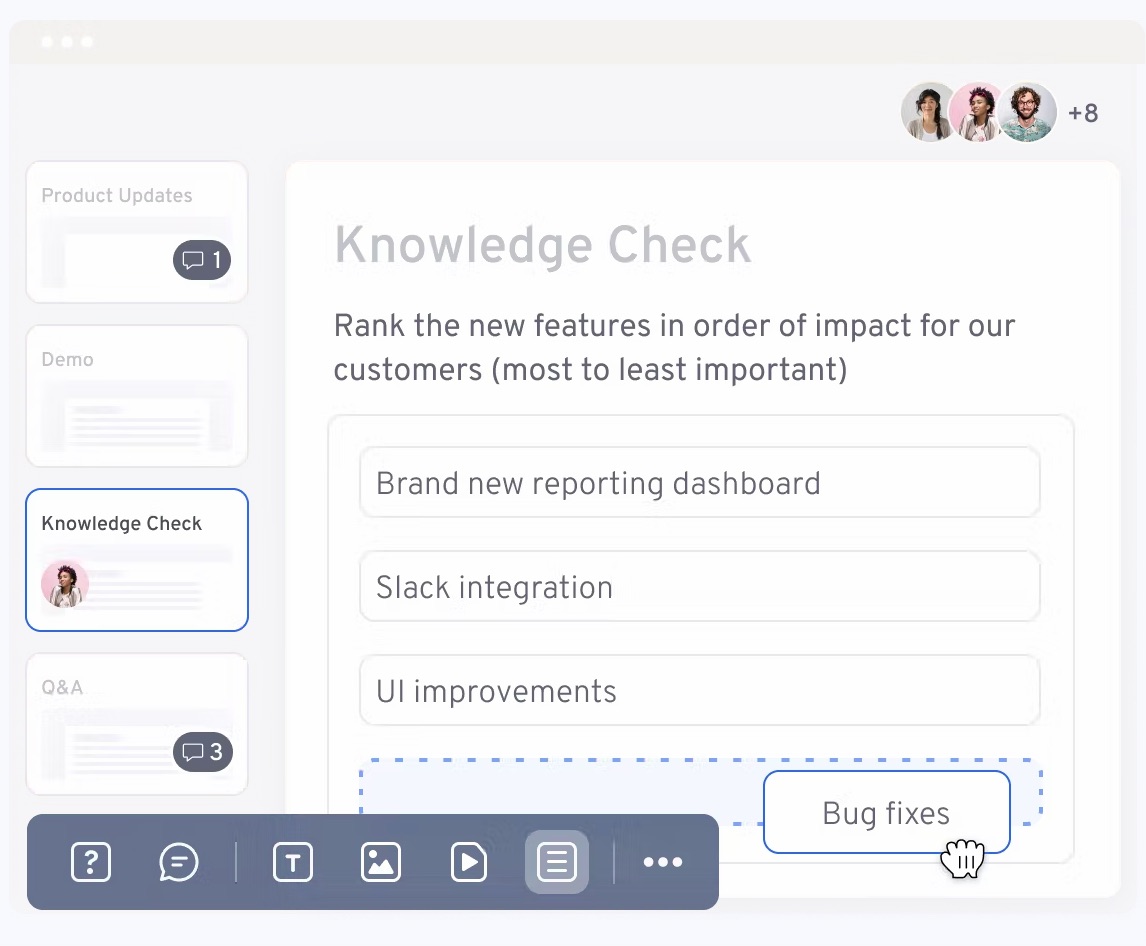
TMS: Training Management System
A Training Management System (TMS) is used by organizations to keep track of the status of their employees taking training programs. Technically, it’s a software tool to administrate, track, report instructor-led training programs. In some way, TMSs are the backoffice system while LMSs are the frontoffice system.
TMSs don’t offer authoring capabilities and they don’t deliver courses. They handle the administration, tracking and compliance. They target the B2B market.
Some TMSs include:
All-in-One Platforms for Course Creators
Some platforms have emerged to help course creators build, market, sell and run their online course under a white label platform.
Here are a couple of questions people usually ask to understand the difference with other types of providers:
What’s the difference with a LMS like Moodle? LMSs are used within an institution (a school). On the other hand, all-in-one platforms enable course authors to create their own website and sell their knowledge (example).
What’s the difference with a marketplace like Udemy? On Udemy your course would be on udemy.com. With an all-in-one platform your get your own website. You don’t “compete” directly with other courses, but on the other hand it’s a bit harder to discover your course: you have to be good at marketing.
Some all-in-one platforms:
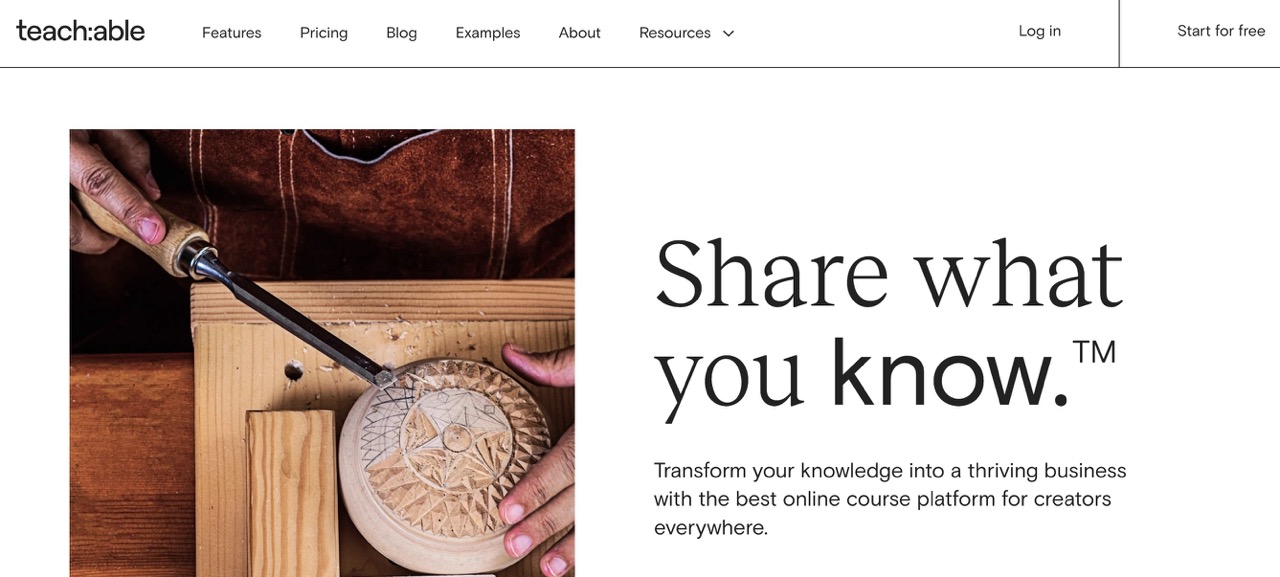
Facilitators
There are different types of facilitators in the education world. Let’s discover a few of them!
OPMs
An OPM (Online Program Management provider) is an facilitator between universities and students who want to learn online.
Many universities don’t have the capability to run online training programs (because they weren’t designed for this, because they aren’t equipped…), so they prefer to delegate the online training service to a specialist. That’s what an OPM is about.
From the university’s point of view, OPM expand their reach to a more global market because of their online capabilities. It means more students for the university, including working adults who may not want to spend a lot of time at a university.
OPMs can do market research, admissions, enrollment, course design, take care of the technology platform, etc. OPMs are mostly for-profit companies.
A few OPM providers: 2U (one of the biggest), Laureate Education, Coursera (OPM is one of their services among others), Pearson Online Learning Services, Keypath Education.
Marketplaces
Marketplaces offer a way for educators to reach an audience of potential students. In some way, they work like any other marketplace… but they focus on education.
Some education marketplaces:
Udemy: one of the biggest, really a marketplace as anyone can build their own course
Skillshare: it’s a bit less seamless to become a teacher but possible (link in the footer)
Pluralsight: focused on IT courses. They are a bit less permissive than Udemy but would allow new teachers with the right credentials
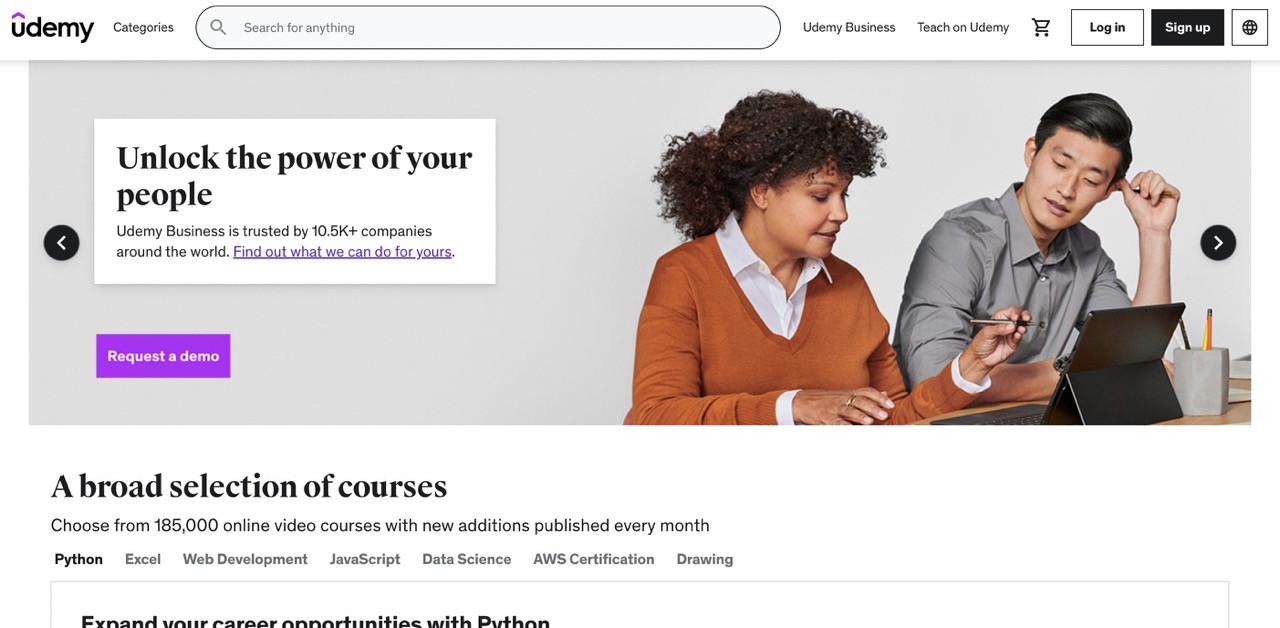
Education-as-a-Benefit Providers
Company workers don’t usually have easy access to education, especially if they want to reskill. These facilitators connect companies with learning providers. This way, for example, a Disney employee can get easy access to training options with existing learning providers.
Some of these facilitators include:
Guild Education: the biggest one
Here’s the summary of the different education stakeholders and the links between them:
